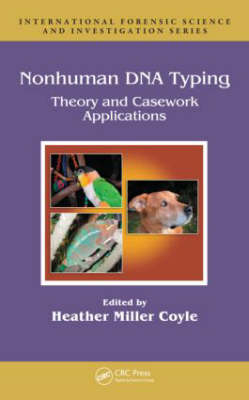
Nonhuman DNA Typing
Theory and Casework Applications
Seiten
2007
Crc Press Inc (Verlag)
978-0-8247-2593-8 (ISBN)
Crc Press Inc (Verlag)
978-0-8247-2593-8 (ISBN)
Presents an introduction to the basic science underlying the field of non-human DNA typing. This book demonstrates the recognition, collection, and preservation of biological evidence, techniques of DNA fingerprinting, and DNA profiling. It describes the STR analysis of canine and feline samples, insects, and fungi, and their role as evidence.
The association of a suspect with the victim or crime scene through DNA evidence is one of the most powerful statements of complicity in a crime imaginable. No category of evidence has ever had the complete capacity to convict or exonerate an accused so absolutely in the eyes of the public. With the discriminatory powers of DNA and the variety of DNA markers now in regular use, the one thing keeping a third of all cases unsolved is the lack of human DNA evidence. However, the identification of polymorphic genetic loci in cats, dogs, plants, insects, bacteria, and viruses can provide the critical link between suspect and scene in the absence of human DNA.
Non-Human DNA Typing: Theory and Casework Applications provides an introduction to the basic science underlying the emerging field of non-human DNA typing. It examines the use of non-human DNA evidence not just in homicide cases, but also in drug trafficking, poaching of endangered species, livestock fraud, and missing persons, as well as the identification of primary and secondary crime scenes. The book demonstrates the recognition, collection, and preservation of biological evidence at a crime scene, techniques of DNA fingerprinting, and DNA profiling. Using a wide variety of examples, applications, and case studies, the author describes the STR analysis of canine and feline samples, insects, and fungi, and their role as evidence in forensic science. Chapters consider the development of testing methods for animal evidence, soil DNA typing, and the use of DNA typing in wildlife investigations. A useful appendix includes an overview of the history of forensic serology and DNA.
Combining science, case examples, legal decisions, and references, Non-Human DNA Typing: Theory and Casework Applications presents the forensic and legal applications of non-human DNA evidence for scientists, law enforcement, and attorneys.
The association of a suspect with the victim or crime scene through DNA evidence is one of the most powerful statements of complicity in a crime imaginable. No category of evidence has ever had the complete capacity to convict or exonerate an accused so absolutely in the eyes of the public. With the discriminatory powers of DNA and the variety of DNA markers now in regular use, the one thing keeping a third of all cases unsolved is the lack of human DNA evidence. However, the identification of polymorphic genetic loci in cats, dogs, plants, insects, bacteria, and viruses can provide the critical link between suspect and scene in the absence of human DNA.
Non-Human DNA Typing: Theory and Casework Applications provides an introduction to the basic science underlying the emerging field of non-human DNA typing. It examines the use of non-human DNA evidence not just in homicide cases, but also in drug trafficking, poaching of endangered species, livestock fraud, and missing persons, as well as the identification of primary and secondary crime scenes. The book demonstrates the recognition, collection, and preservation of biological evidence at a crime scene, techniques of DNA fingerprinting, and DNA profiling. Using a wide variety of examples, applications, and case studies, the author describes the STR analysis of canine and feline samples, insects, and fungi, and their role as evidence in forensic science. Chapters consider the development of testing methods for animal evidence, soil DNA typing, and the use of DNA typing in wildlife investigations. A useful appendix includes an overview of the history of forensic serology and DNA.
Combining science, case examples, legal decisions, and references, Non-Human DNA Typing: Theory and Casework Applications presents the forensic and legal applications of non-human DNA evidence for scientists, law enforcement, and attorneys.
University of New Haven, West Haven, Connecticut, USA
An Introduction to Forensic Science and DNA, Collection and Preservation of Biological Evidence from the Crime Scene, Techniques of DNA Fingerprinting, Forensic Canine STR Analysis, STR Based Forensic Analysis of Felid Samples from Domestic and Exotic Cats, An Overview of Insect Evidence in Forensic Science, Use of Forensic DNA Typing in Wildlife Investigations, DNA Testing of Animal Evidence - Case Examples and Method Development Basics of Forensic Fungi, Soil DNA Typing in Forensic Science, DNA Profiling: The Ability to Predict an Image from a DNA Profile, APPENDIX: A Brief History of Forensic Serology and DNA,
| Erscheint lt. Verlag | 29.8.2007 |
|---|---|
| Reihe/Serie | International Forensic Science and Investigation |
| Zusatzinfo | 13 Tables, black and white; 20 Halftones, black and white; 50 Illustrations, black and white |
| Verlagsort | Bosa Roca |
| Sprache | englisch |
| Maße | 156 x 234 mm |
| Gewicht | 476 g |
| Themenwelt | Studium ► Querschnittsbereiche ► Epidemiologie / Med. Biometrie |
| Naturwissenschaften ► Biologie ► Genetik / Molekularbiologie | |
| Recht / Steuern ► Strafrecht ► Kriminologie | |
| ISBN-10 | 0-8247-2593-X / 082472593X |
| ISBN-13 | 978-0-8247-2593-8 / 9780824725938 |
| Zustand | Neuware |
| Haben Sie eine Frage zum Produkt? |
Mehr entdecken
aus dem Bereich
aus dem Bereich
ein überfälliges Gespräch zu einer Pandemie, die nicht die letzte …
Buch | Hardcover (2024)
Ullstein Buchverlage
24,99 €


